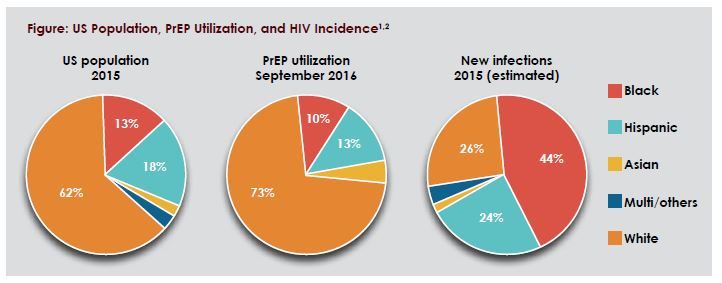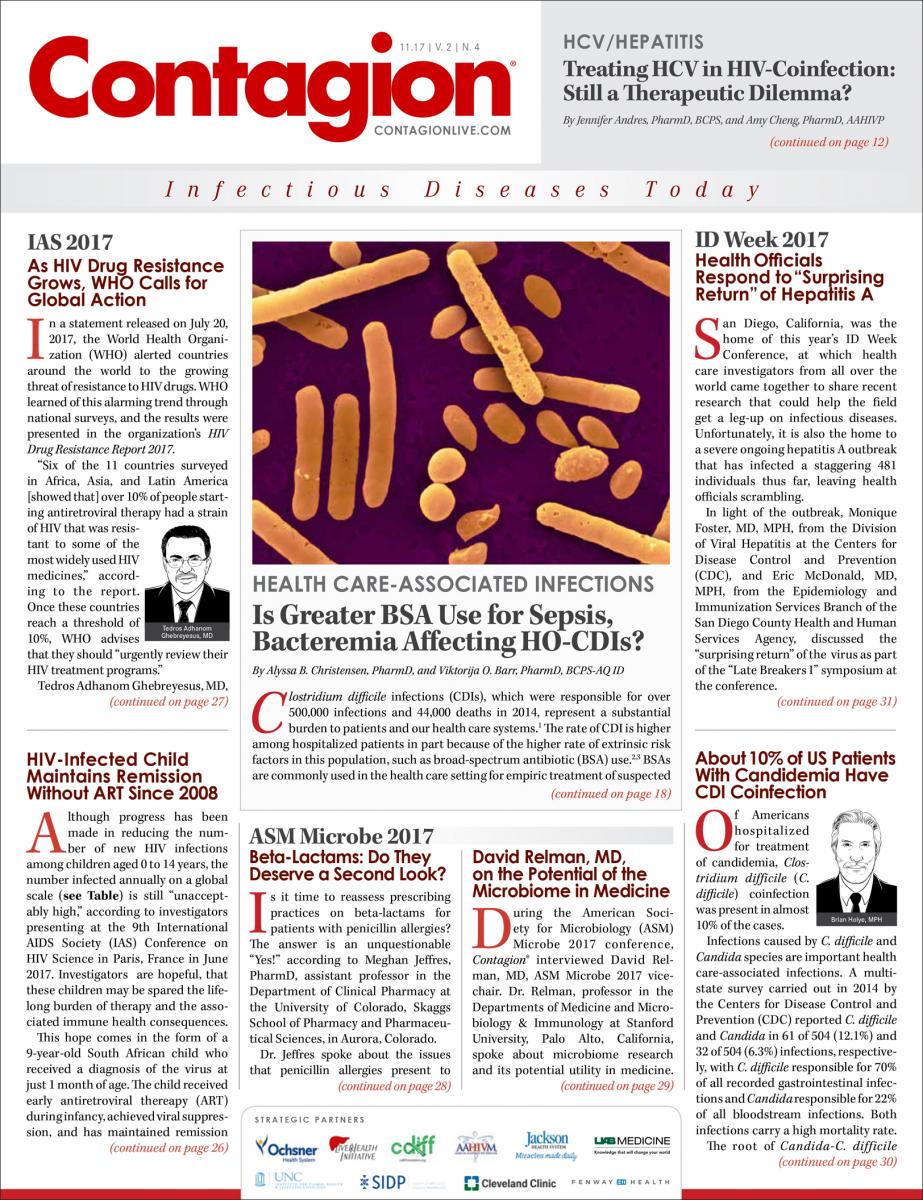The State of PrEP in 2017: Recent Data and Current Challenges
Although a once-daily pill to prevent HIV exists, US populations at highest risk have the lowest rates of usage.
Since it was approved by the US Food and Drug Administration (FDA) in 2012, preexposure prophylaxis (PrEP) has changed the HIV prevention landscape in the United States. At the end of the first quarter of 2017, an estimated 120,000 Americans were taking emtricitabine/ tenofovir disoproxil fumarate (FTC/TDF) for PrEP. The number of new prescriptions remained stable at around 11,000 per quarter in 2016. This is good news for domestic prevention efforts, but data presented at the 2017 International AIDS Conference in Paris, France,
1
highlight some of the continued challenges faced in our expansion of PrEP.
Investigators from Gilead Sciences, the manufacturer of FTC/TDF, examined pharmacy fulfillment data from January 2012 through September 2016
2
to describe trends and patterns in prescribing. In the first 2 years following FTC/TDF’s approval, women made up almost half (42%) of all individuals prescribed FTC/TDF for HIV prevention. Since 2014, the proportion of women has decreased dramatically, currently accounting for only 15% of all recipients. In addition, young adults represent a disproportionately small number of PrEP users relative to their importance as a key risk group
3
; just 11% of men and 24% of women prescribed PrEP were under age 25. Although only 40% of prescriptions had associated race and ethnicity information, the trends seem likely to reflect fundamental inequities in health care access across the United States. In 2015, blacks and Hispanics/Latinos accounted for 45% and 24% of all new HIV diagnoses
4
in the United States, respectively, yet they comprised less than a quarter of all PrEP recipients (13% Hispanic/Latino, 10% black) across the 4 years of available data. (Figure).

Taken together, the unevenness of PrEP’s uptake across at-risk groups highlights the work that remains to be done in implementation and scale-up; bringing attention to these disparities is a necessary first step in bringing about change. However, it is important to keep in mind that although PrEP can have a meaningful impact on HIV incidence, it is by no means a magic bullet.
In fact, modeling data from the Centers for Disease Control and Prevention (CDC)
5
estimate that PrEP implementation can be expected to avert approximately 17,000 new infections over a 5-year period, assuming all the goals of the National HIV/AIDS Strategy
6
are reached. In contrast, 168,000 infections could be prevented if 85% of individuals diagnosed with HIV were linked with care, and 80% of those linked with care are virologically suppressed. Clearly, antiretrovirals used as PrEP and treatment as prevention have an important role to play in controlling the domestic epidemic, but their potential has not yet been fully realized.
Where do we go from here? Gilead’s data suggest that over the past year, the number of new prescriptions for PrEP has plateaued, but there are more than 120,000 people in the United States who are potential candidates for PrEP. Indeed, CDC analyses
7
suggest that 1 in every 4 men who have sex with men, 1 in every 5 individuals who inject drugs, and 1 in every 200 heterosexuals has at least 1 indication for PrEP per the US Public Health Service’s 2014 guidelines,
8
for a total of about 1.2 million Americans.
Those of us in the HIV prevention community need to expand our efforts to introduce and demystify PrEP for frontline providers and members of key, at-risk populations. Across the country, local AIDS education and training centers
9
have taken up this challenge. At the North Carolina AIDS Training & Education Center (NCATEC), we have partnered successfully with state and local health departments, AIDS advocacy groups, and community-based organizations to work on PrEP expansion. Since our efforts began in late 2014, NCATEC has curated a searchable map of known prescribers,
10
allowing both consumers and providers to identify access points nearby. Examination of our map over time has allowed us to identify geographic gaps in service availability, which largely (and unsurprisingly) fall in rural, impoverished areas. In these communities, access to health care often depends on safety net providers located in community and rural health centers and public health department clinics. In collaboration with Duke University, we have examined barriers to PrEP expansion into local health departments
11
and are working on localized, tailored solutions to address them.
In addition to our work with rural PrEP access, we have partnered with campus health centers across the state’s university system to make sure they are able to provide comprehensive sexual health services to their students. The specific inclusion of historically black colleges and universities has been an important part of our outreach efforts in North Carolina, as well, with trainings on their campuses provided by infectious diseases clinical faculty from both the University of North Carolina and Duke University.
Our success in PrEP implementation in a rural Southern state is a source of pride, but we have much work to do in the years to come. As we gather data on the state of PrEP expansion, we must continue to share our findings with advocacy groups and policy makers to shine a light on the structural inequalities that are restricting access. This is especially true in states that opted not to expand Medicaid,12 many of which are in the Southeast; the uncertain fate of the Patient Protection and Affordable Care Act has further complicated the situation for some at-risk individuals. Although those living with HIV can leverage a variety of services to help stably engage in care, none of those are available to uninfected, at-risk individuals—even though they often face similar challenges in transportation, employment, unstable housing, and care for mental health or substance use. These are formidable challenges to be sure, but not insurmountable, provided that there is political will and pressure applied from knowledgeable professionals like you.
Dr. Hurt is an assistant professor of medicine at the Institute for Global Health and Infectious Diseases at the University of North Carolina at Chapel Hill (UNC). He established the UNC Infectious Diseases Clinic’s PrEP program and coordinates PrEP-related education and outreach efforts of the North Carolina AIDS Training and Education Center, housed at UNC. Dr. Hurt also serves as the site principal investigator for HIV Prevention Trials Network Study 083, the first study to compare oral PrEP with a long-acting injectable medication (the integrase inhibitor cabotegravir) for HIV prevention in at-risk men who have sex with men and transgender women.
References
- Ryan B. An estimated 136,000 people are on PrEP in the US. POZ website. www.poz.com/article/estimated-136000-people-prep-us. Published August 18, 2017. Accessed September 12, 2017.
- Mera Giler, R, Magnuson D, Trevor H, Bush S, Rawlings K, McCallister S. Changes in Truvada (TVD) for HIV pre-exposure prophylaxis (PrEP) utilization in the United States: (2012-2016). Abstract presented at: 2017 International AIDS Society Meeting; July 23-26, 2017; Paris, France. http://programme.ias2017.org/Abstract/Abstract/1614. Accessed September 12, 2017.
- HIV among youth. CDC website. www.cdc.gov/hiv/group/age/youth/index.html. Updated August 24, 2017. Accessed September 12, 2017.
- HIV in the United States: at a glance. CDC website. www.cdc.gov/hiv/statistics/overview/ataglance.html. Updated September 8, 2017. Accessed September 12, 2017.
- Yaylali E, Farnham P, Jacobson E, et al. Impact of improving HIV care and treatment and initiating PrEP in the United States, 2015-2020. Abstract presented at: 2017 Conference on Retroviruses and Opportunistic Infections (CROI); February 22-25, 2016; Boston, MA. www.croiconference.org/sessions/impact-improving-hiv-care-and-treatment-and-initiating-prep-united-states-2015-2020. Accessed September 12, 2017.
- National HIV/AIDS strategy: updated to 2020. HIV.gov website. www.hiv.gov/federal-response/national-hiv-aids-strategy/nhas-update. Updated January 31, 2017. Accessed September 12, 2017.
- Smith DK, Van Handel M, Wolitski RJ, et al. Vital signs: estimated percentages and numbers of adults with indications for preexposure prophylaxis to prevent HIV acquisition—United States, 2015. MMWR Morb Mortal Wkly Rep. 2015;64(46);1291-1295. doi: 10.15585/mmwr.mm6446a4.
- US Public Health Service. Preexposure prophylaxis for the prevention of HIV infection in the United States—2014: a clinical practice guideline. www.cdc.gov/hiv/pdf/prepguidelines2014.pdf. Published May 14, 2014. Accessed September 12, 2017.
- AIDS Education and Training Center Program website. https://aidsetc.org/. Accessed September 12, 2017.
- Consumers interested in or currently taking PrEP. University of North Carolina School of Medicine website. http://www.med.unc.edu/ncaidstraining/prep/PrEP-for-consumers. Accessed September 12, 2017.
- Zhang H, Rhea S, Fleischauer A, et al. Limited implementation of HIV pre-exposure prophylaxis among public health departments in North Carolina, United States. Abstract presented at: 2017 International AIDS Society Meeting; July 23-26, 2017; Paris, France. http://programme.ias2017.org/Abstract/Abstract/1007. Accessed September 12, 2017.
- Status of state action on the Medicaid expansion decision. Kaiser Family Foundation website. http://www.kff.org/health-reform/state-indicator/state-activity-around-expanding-medicaid-under-the-affordable-care-act/. Updated January 1, 2017. Accessed September 12, 2017.





















